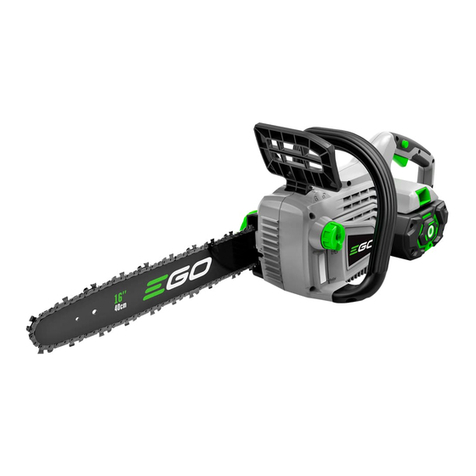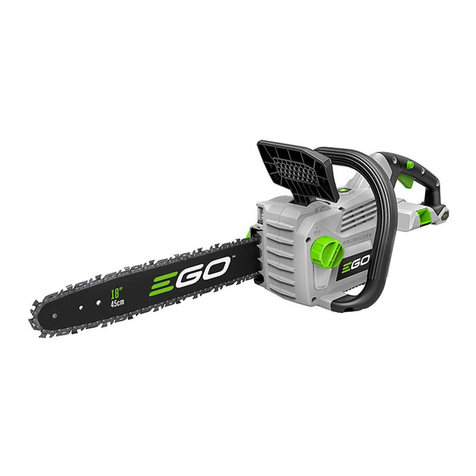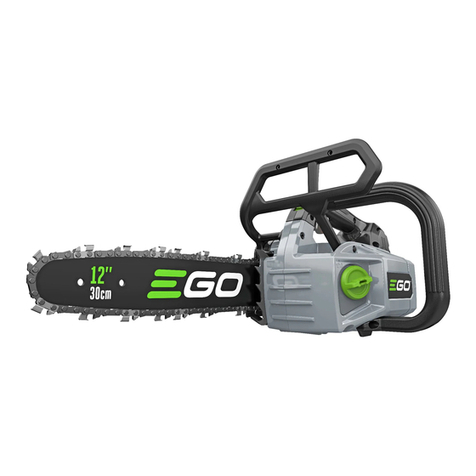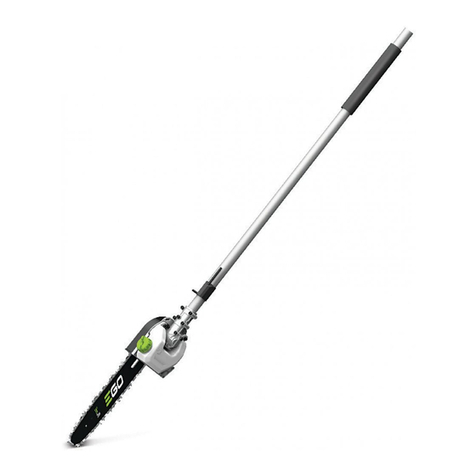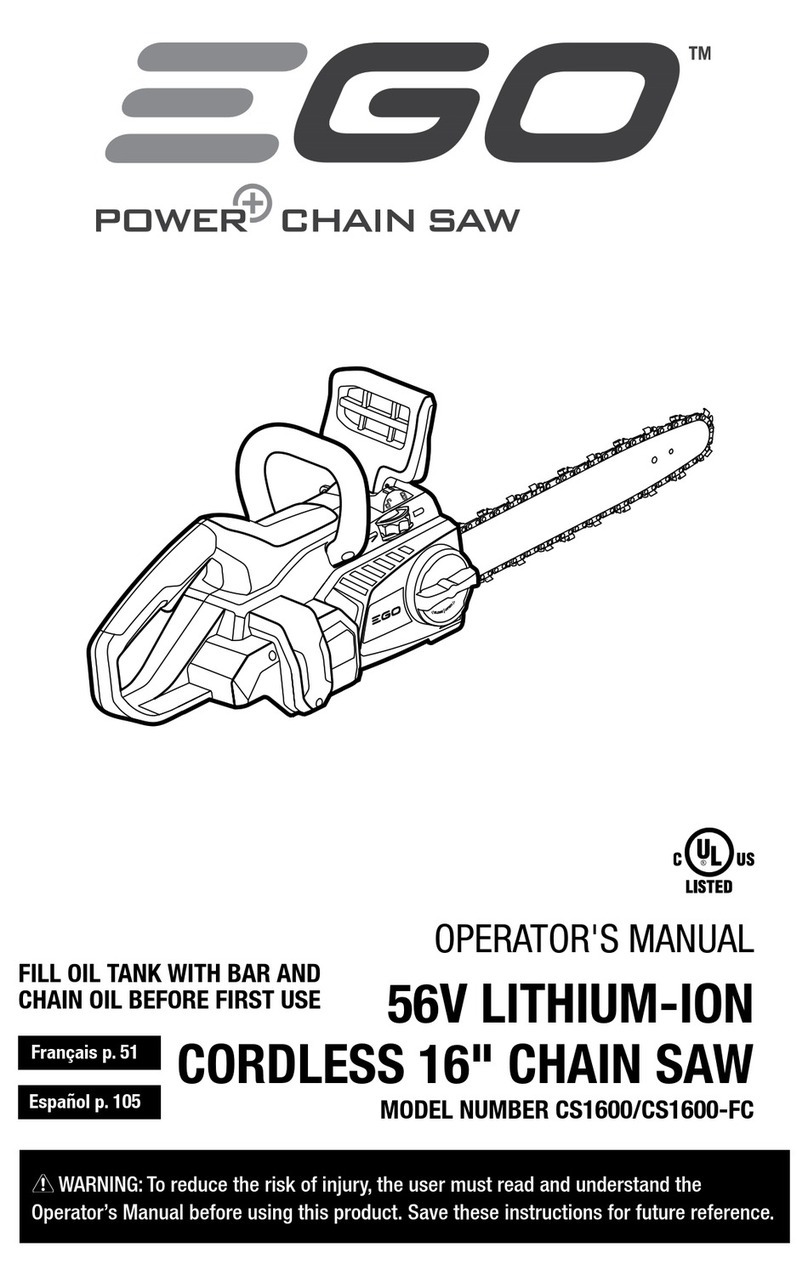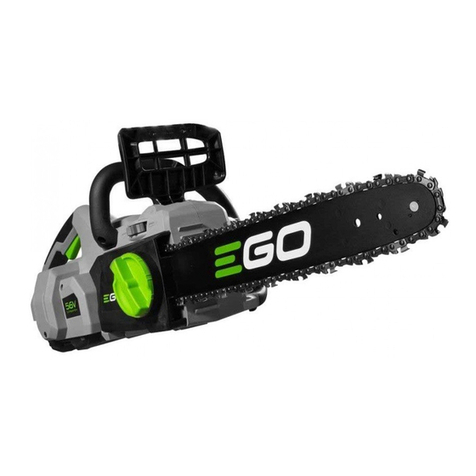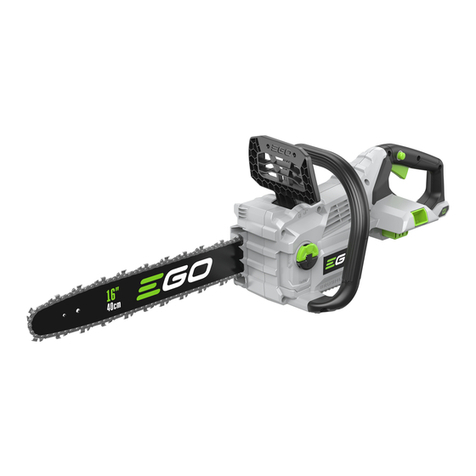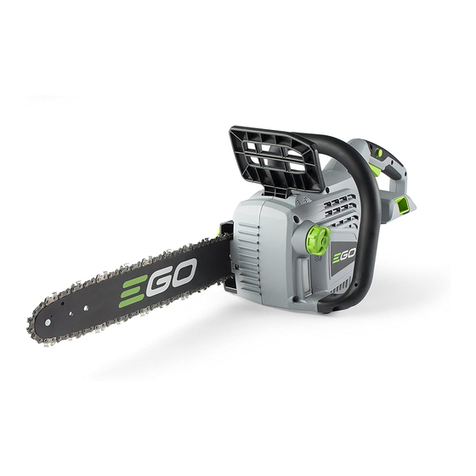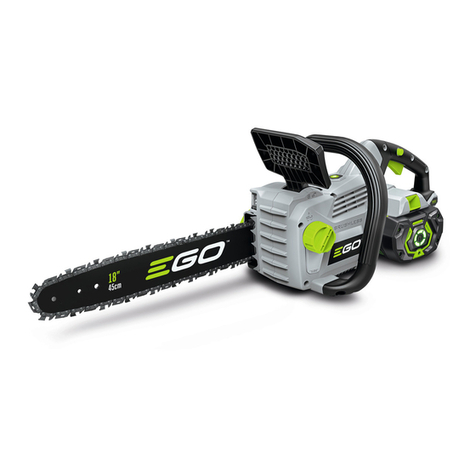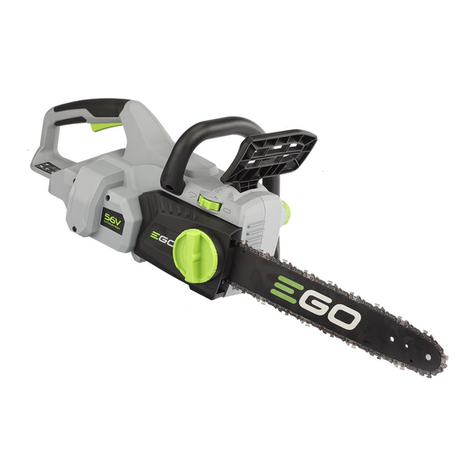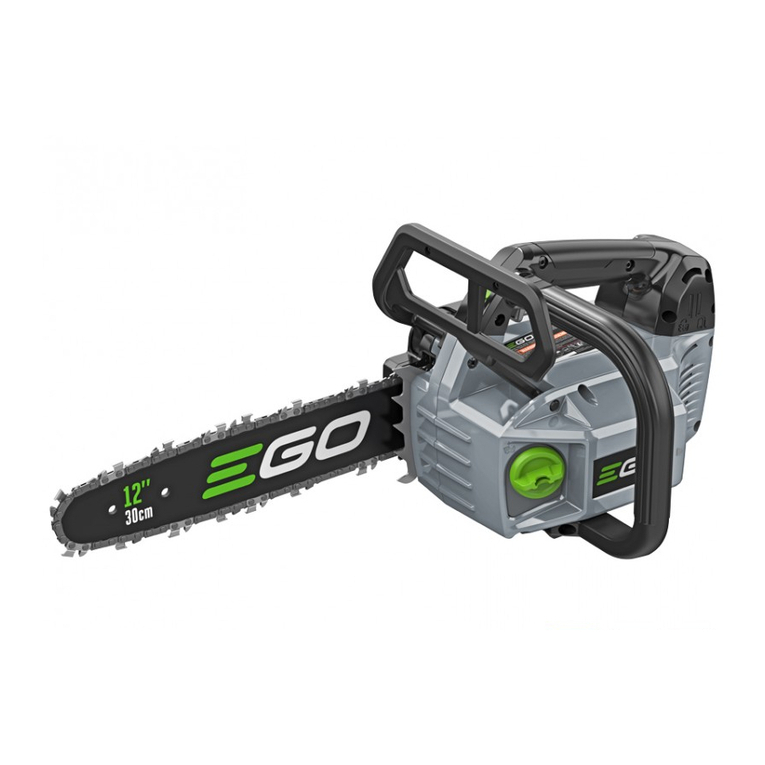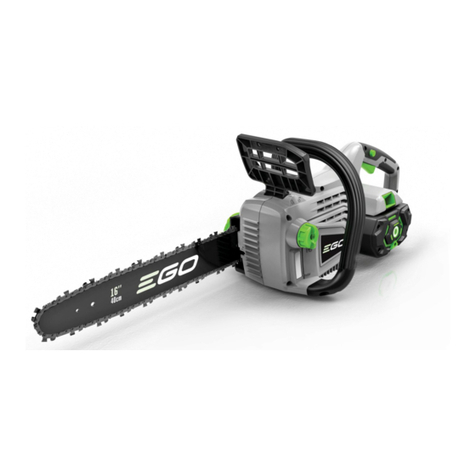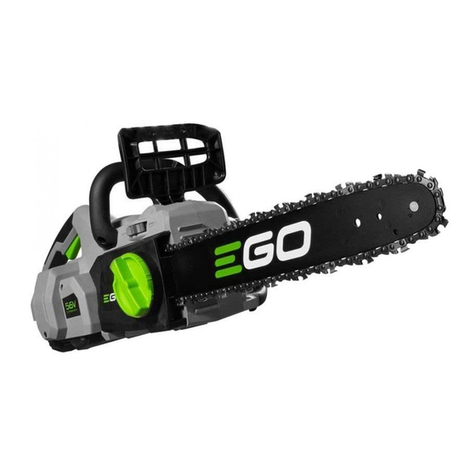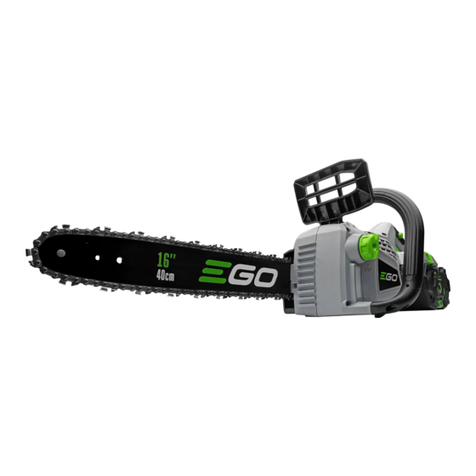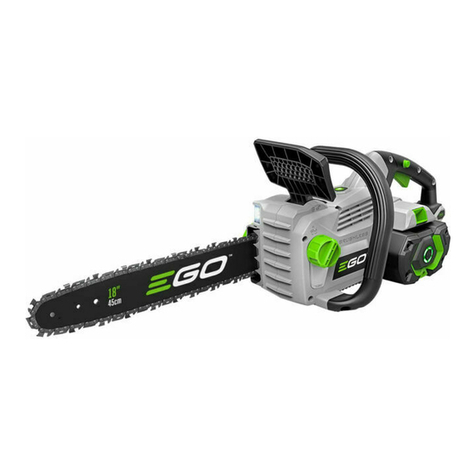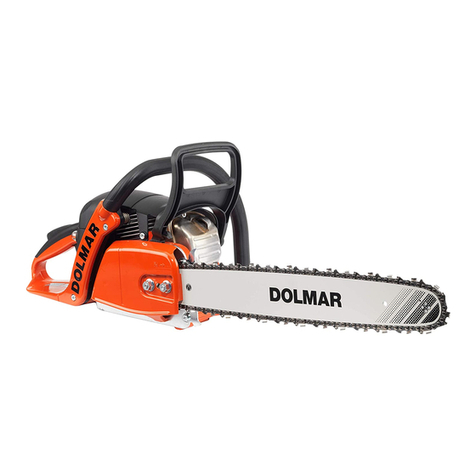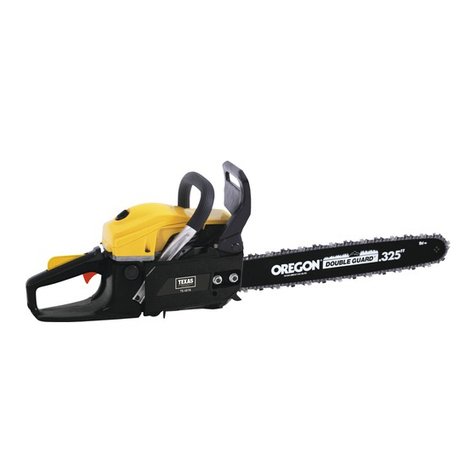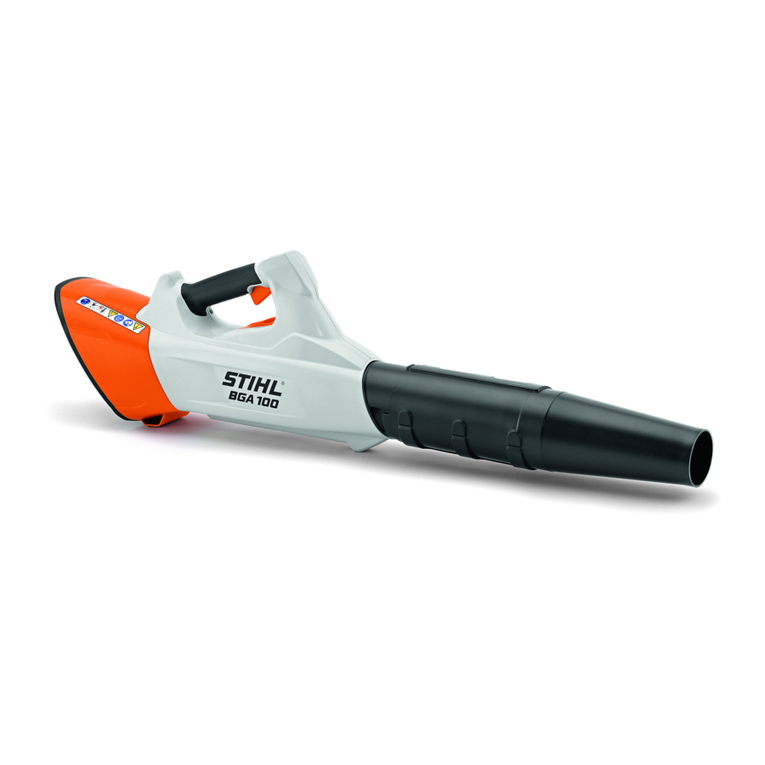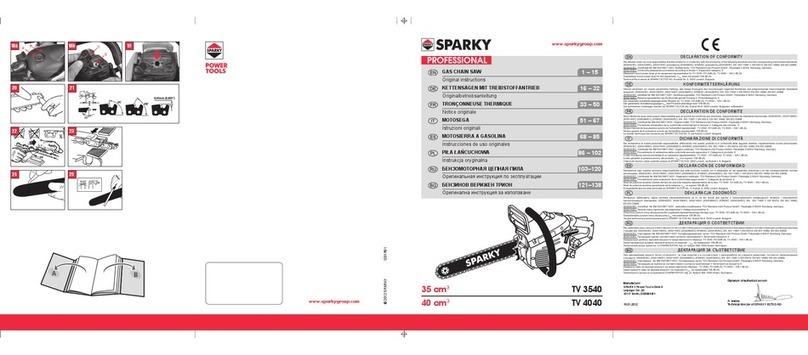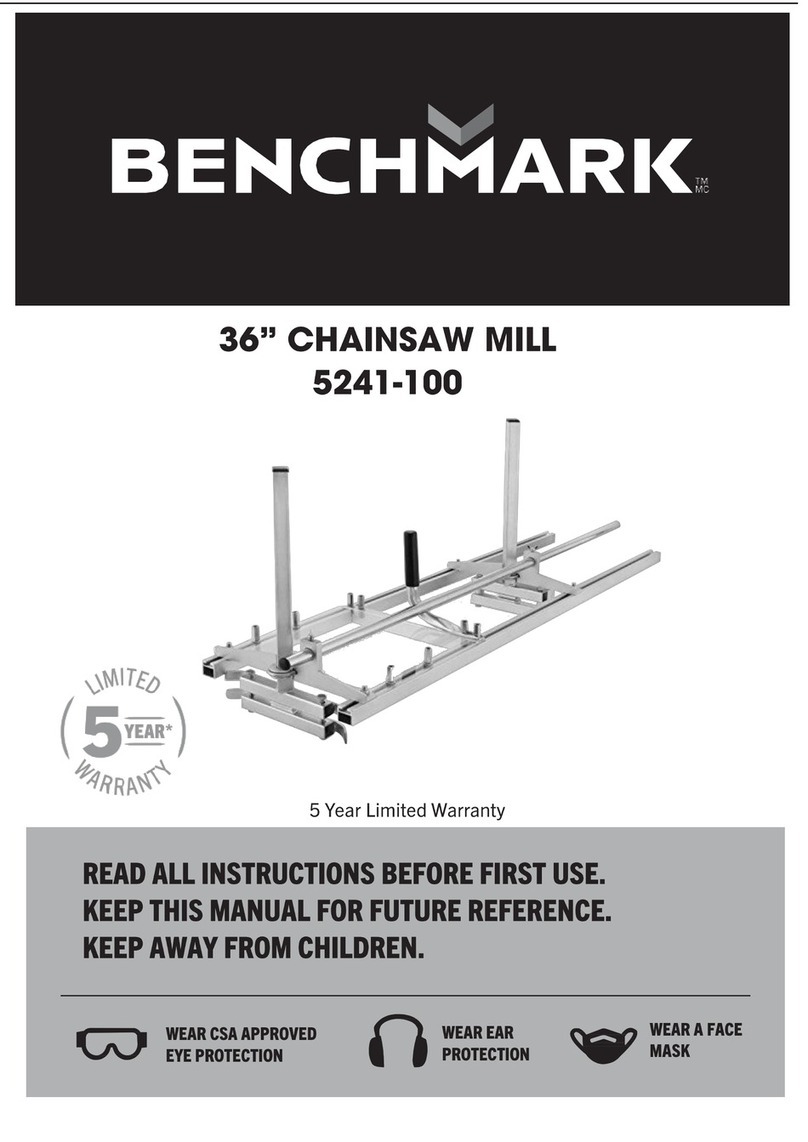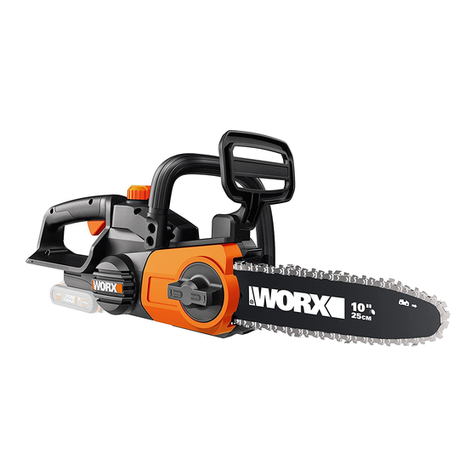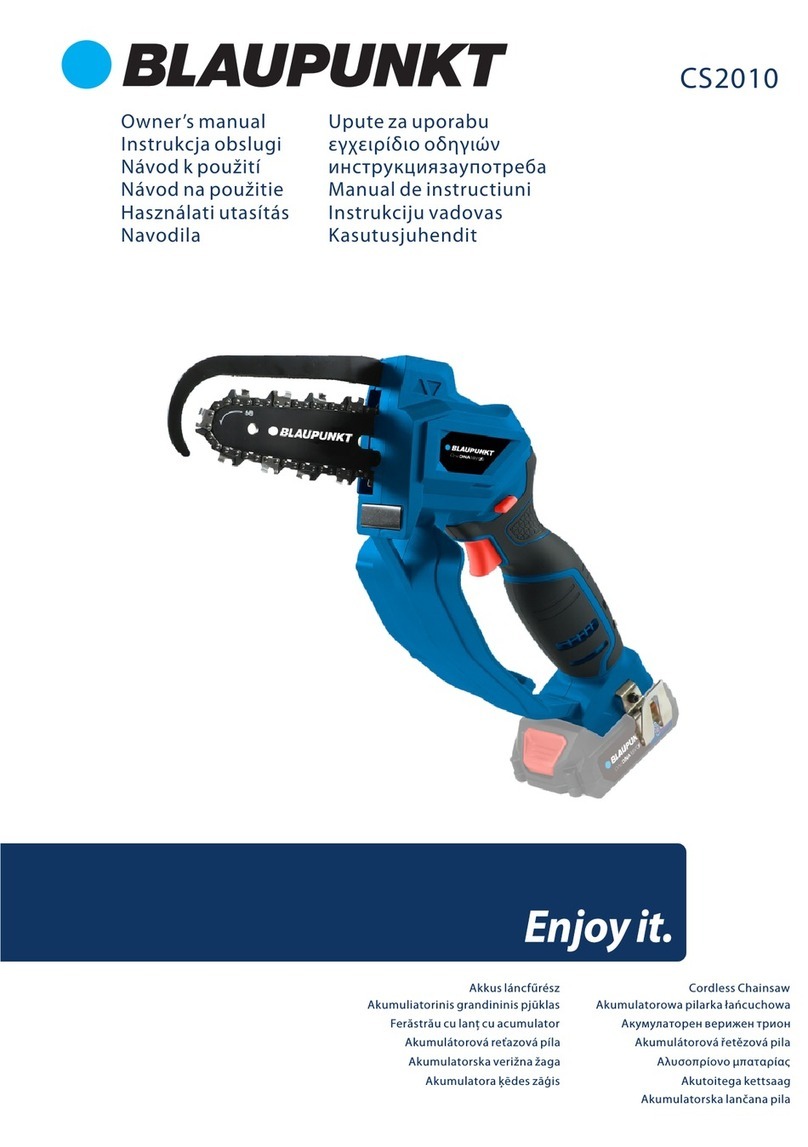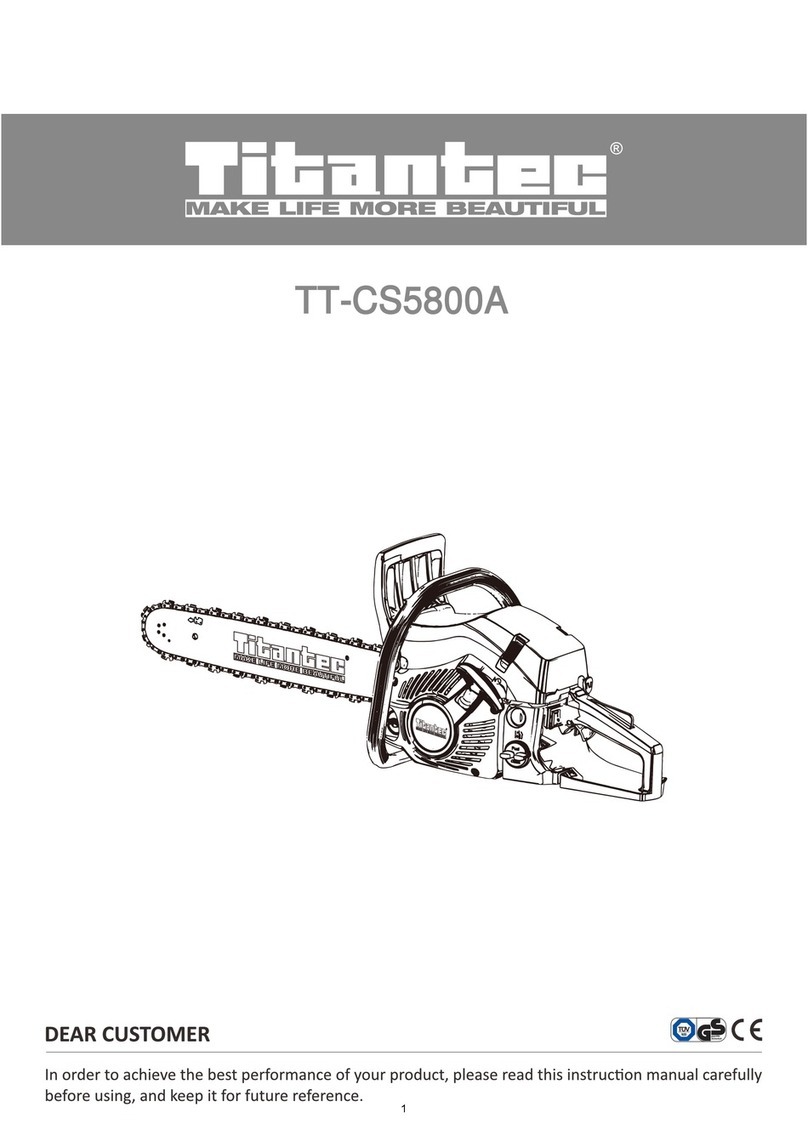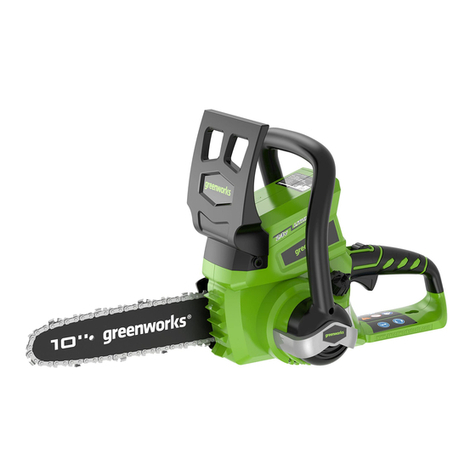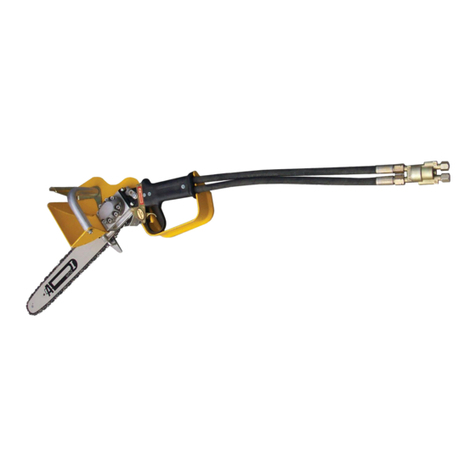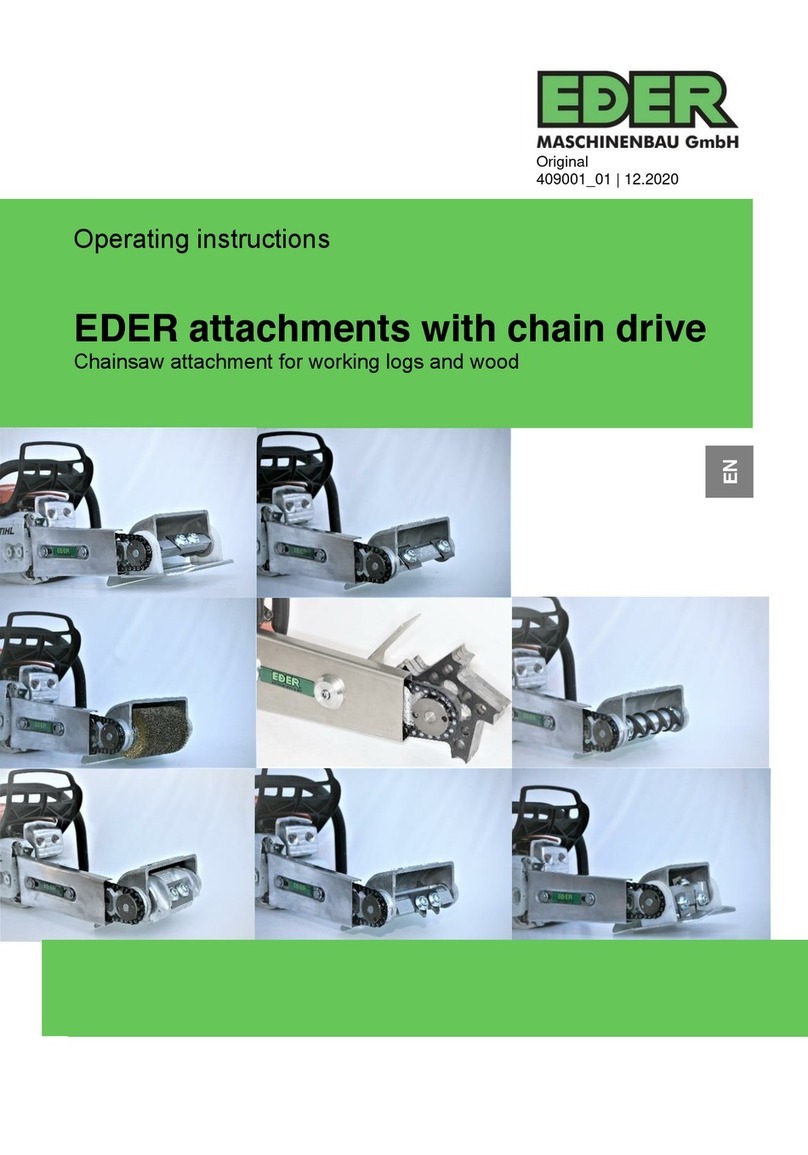EGO CSX5000 User manual

MNL_EGO_CSX5000_AV03.01_231031
OPERATOR’S MANUAL
56 VOLT LITHIUM-ION
COMMERCIAL CORDLESS
CHAINSAW
MODEL NUMBER CSX5000
WARNING: To reduce the risk of injury, the user must read and understand the
Operator’s Manual before using this product. Save these instructions for future reference.
COMMERCIAL

1. Saw Chain
2. Chain-kickback
Brake Paddle 3. Front
Handle
4. LCD Screen
5. Speed Level
6.
Bluetooth®
Icon
8. Brake Icon
7. Headlight Icon
9. High-temperature
Indicator
10. Fuel-gauge
Circle
12. Low Oil
Indicator
11. Load Level
13. Headlight/
Bluetooth®
Button
14. Oil-feeding
Button
16. Lock-off Button
17. Trigger Switch
18. Rear Handle
19. Chain Speed Shifter
20. Battery
Release Button
21. Oil-inspection Window
23. Guide Bar 22. Oil-tank Cap
25. Chain-tensioning Bolt
26. Side Cover 27. Lock Nuts
28. Bucking Spikes
29. LED Headlight
31. Multi-Wrench
30. Chain Sheath
24. Lubricating
Hole
15. Oil
Output Level
Kickback danger
zone
A
BCRotational
kickback

J
G
E
F
H
I
D
Linear kickback
Kickback
Pinch
Pull Push
Lock Nuts
Side Cover
Chain-
tensioning
Bolt
Rotation
Direction Chain Cutters
Chain Drive Links
Chain Drive
Links
Guide Bar
Groove

P
N
K2
LM
O1
O2
1.3 mm
Rotation
Direction Arrow
K1
Chain-tensioning Bolt
Sprocket

Chain Line
S1 S2
U1
U2
Q
T
U3
Low Brightness
Headlight Icon
LED Headlight
High Brightness
Headlight Icon
Lock-off Button
Trigger Switch
Gripping Area
Bluetooth®Icon
Headlight Icon
Brake Icon High-
temperature
Indicator
Load Level
Oil Output
Level
Headlight/
Bluetooth®
Button
Oil-feeding
Button
Low Oil
Indicator
Speed
Level
Fuel-gauge
Circle
Chain Speed
Shifter
R
Sensors WILL detect
sudden motion in this
plane.
Sensors will NOT detect
sudden motion in this
plane.
Grip with thumb
below handle
Chain Line
Straight Arm
Position

Bottom Cover
Y
X
V2 Notching
Undercut
Felling back
cut
Direction of fall
Notch
Hinge
50.8 mm
50.8 mm
V3
Limb Cut
Tree Limbing W1 Log Supported Along the Entire Length
Cut From Top (Overbuck)
Avoid Cutting Earth
45°
V1
Dangerous Zone
Dangerous
Zone
Felling Direction
Safety
Retreat Path
Safety
Retreat Path
W2 Log Supported One End
2nd Cut Overbuck (2/3 Diameter) to Meet 1st Cut (To
Avoid Pinching)
1st Cut Underbuck (1/3 Diameter) to Avoid Splintering
W3 Log Supported Both Ends
1st Cut Overbuck (1/3 Diameter) to Avoid Splintering
2nd Cut Underbuck (2/3 Diameter) to Meet 1st Cut
(To Avoid Pinching)

Z2
Z3
Z1
Lubricating Hole
Sprocket in
Guide Bar Tip

56 VOLT LITHIUM-ION COMMERCIAL CORDLESS CHAINSAW — CSX50008
READ ALL INSTRUCTIONS!
READ OPERATOR’S MANUAL
WARNING: To ensure safety and reliability, all repairs
and replacements should be performed by a qualified
service technician.
SAFETY SYMBOLS
The purpose of safety symbols is to attract your attention
to possible dangers. The safety symbols and the
explanations with them deserve your careful attention
and understanding. The symbol warnings do not, by
themselves, eliminate any danger. The instructions and
warnings they give are no substitutes for proper accident
prevention measures.
WARNING: Be sure to read and understand all
safety instructions in this Operator’s Manual, including
all safety alert symbols such as “DANGER,” “WARNING,”
and “CAUTION” before using this tool. Failure to follow all
instructions listed below may result in electric shock, fire,
and/or serious personal injury.
SYMBOL MEANING
SAFETY ALERT SYMBOL: Indicates DANGER, WARNING,
or CAUTION. May be used in conjunction with other
symbols or pictographs.
WARNING: The operation of any
power tools can result in foreign objects
being thrown into your eyes, which can
result in severe eye damage. Before
beginning power tool operation, always
wear safety goggles or safety glasses with
side shields and a full face shield when
needed. We recommend a Wide Vision
Safety Mask for use over eyeglasses or
standard safety glasses with side shields.
SAFETY INSTRUCTIONS
This page depicts and describes safety symbols that may
appear on this product. Read, understand, and follow
all instructions on the machine before attempting to
assemble and operate.
SAFETY SYMBOLS
Safety Alert Indicates a potential
personal injury hazard.
Read
Operator’s
Manual
To reduce the risk of
injury, user must read
operator’s manual.
Wear Eye
Protection
Always wear safety
goggles or safety
glasses with side shields
and a full face shield
when operating this
product.
Wear Ear
Protection
Always wear ear
protection when
operating this product.
Wear Head
Protection
Wear an approved safety
hard hat to protect your
head.
Wear
Protective
Gloves
Protect your hands with
gloves when handling
saw and saw chain.
Heavy-duty, nonslip
gloves improve your grip
and protect your hands.
Guide Bar The information of guide
bar.
Be Aware
of Kickback
Beware of chainsaw
kickback and avoid
contact with bar tip
Guide
Bar Tip
Kickback
Tip contact can cause
the guide bar to move
suddenly upward and
backward, which can
cause serious injury.
Two
Handed
hold
Always use chainsaw
two-handed
Regulatory
Compliance
Mark
This product complies
with applicable
Australian standards.
XX
Noise Guaranteed sound power
level

56 VOLT LITHIUM-ION COMMERCIAL CORDLESS CHAINSAW — CSX5000 9
◾Avoid body contact with earthed or grounded
surfaces, such as pipes, radiators, ranges and
refrigerators. There is an increased risk of electric
shock if your body is earthed or grounded.
◾Do not expose power tools to rain or wet
conditions. Water entering a power tool will increase
the risk of electric shock.
◾Do not abuse the cord. Never use the cord for
carrying, pulling or unplugging the power tool.
Keep cord away from heat, oil, sharp edges or
moving parts. Damaged or entangled cords increase
the risk of electric shock.
◾When operating a power tool outdoors, use an
extension cord suitable for outdoor use. Use of
a cord suitable for outdoor use reduces the risk of
electric shock.
◾If operating a power tool in a damp location is
unavoidable, use a Ground-fault circuit interrupter
protected supply. Use of GFCI reduces the risk of
electric shock.
PERSONAL SAFETY
◾Stay alert, watch what you are doing and use
common sense when operating a power tool. Do
not use a power tool while you are tired or under
the influence of drugs, alcohol medication. A
moment of inattention while operating power tools may
result in serious personal injury.
◾Use personal protective equipment. Always wear
eye protection. Protective equipment such as a dust
mask, non-skid safety shoes, hard hat or hearing
protection used for appropriate conditions will reduce
personal injuries.
◾Prevent unintentional starting. Ensure the switch
is in the off-position before connecting to power
source and/or battery pack, picking up or carrying
the tool. Carrying power tools with your finger on the
switch or energizing power tools that have the switch
on invites accidents.
◾Remove any adjusting key or wrench before
turning the power tool on. A wrench or a key left
attached to a rotating part of the power tool may result
in personal injury.
◾Do not overreach. Keep proper footing and balance
at all times. This enables better control of the power
tool in unexpected situations.
◾Dress properly. Do not wear loose clothing or
jewellery. Keep your hair, clothing and gloves away
from moving parts. Loose clothes, jewelry or long hair
can be caught in moving parts.
Direct
Current
Type or a characteristic
of current
V Volt Voltage
A Amperes Current
Hz Hertz Frequency (cycles per
second)
WWatt Power
min Minutes Time
n0
No Load
Speed
Rotational speed, at
no load
... /min Per Minute Revolutions per minute
IPX5
Ingress
Protection
Degree
Protection Against Water
Jets
GENERAL POWER TOOL SAFETY WARNINGS
WARNING: Read all safety warnings, instructions,
illustrations and specifications provided with this
power tool. Failure to follow all instructions listed below
may result in electric shock, fire and/or serious injury
SAVE ALL WARNINGS AND INSTRUCTIONS FOR FUTURE
REFERENCE.
The term “power tool” in the warnings refers to your
mains-operated (corded) power tool or battery-operated
(cordless) power tool.
WORK AREA SAFETY
◾Keep work area clean and well lit. Cluttered or dark
areas invite accidents.
◾Do not operate power tools in explosive
atmospheres, such as in the presence of
flammable liquids, gases or dust. Power tools create
sparks which may ignite the dust or fumes.
◾Keep children and bystanders away while
operating a power tool. Distractions can cause you
to lose control.
ELECTRICAL SAFETY
◾Power tool plugs must match the outlet. Never
modify the plug in any way. Do not use any adaptor
plugs with earthed (grounded) power tools.
Unmodified plugs and matching outlets will reduce risk
of electric shock

56 VOLT LITHIUM-ION COMMERCIAL CORDLESS CHAINSAW — CSX500010
of battery pack may create a risk of fire when used
with another battery pack.
◾Use power tools only with specifically designated
battery packs. Use of any other battery packs may
create a risk of injury and fire.
◾When battery pack is not in use, keep it away from
other metal objects, like paper clips, coins, keys,
nails, screws or other small metal objects, that can
make a connection from one terminal to another.
Shorting the battery terminals together may cause
burns or a fire.
◾Under abusive conditions, liquid may be ejected
from the battery; avoid contact. If contact
accidentally occurs, flush with water. If liquid
contacts eyes, additionally seek medical help. Liquid
ejected from the battery may cause irritation or burns.
◾Do not use a battery pack or tool that is damaged
or modified. Damaged or modified batteries may
exhibit unpredictable behavior resulting in fire,
explosion or risk of injury.
◾Do not expose a battery pack or tool to fire
or excessive temperature. Exposure to fire or
temperature above 130°C may cause explosion.
◾Follow all charging instructions and do not charge
the battery pack or tool outside the temperature
range specified in the instructions. Charging
improperly or at temperatures outside the specified
range may damage the battery and increase the risk
of fire.
SERVICE
◾Have your power tool serviced by a qualified repair
person using only identical replacement parts.
This will ensure that the safety of the power tool is
maintained.
◾Never service damaged battery packs. Service
of battery packs should only be performed by the
manufacturer or authorized service providers.
CHAINSAW SAFETY WARNINGS
◾Keep all parts of the body away from the saw chain
when the chainsaw is operating. Before you start
the chainsaw, make sure the saw chain is not
contacting anything. A moment of inattention while
operating chainsaws may cause entanglement of your
clothing or body with the chain.
◾Always hold the chainsaw with your right hand
on the rear handle and your left hand on the front
handle. Holding the chainsaw with a reversed hand
configuration increases the risk of personal injury and
should never be done.
◾If devices are provided for the connection of dust
extraction and collection facilities, ensure these
are connected and properly used. Use of dust
devices can reduce dust-related hazards.
◾Do not let familiarity gained from frequent use of
tools allow you to become complacent and ignore
tool safety principles. A careless action can cause
severe injury within a fraction of a second
POWER TOOL USE AND CARE
◾Do not force the power tool. Use the correct power
tool for your application. The correct power tool will
do the job better and safer at the rate for which it was
designed.
◾Do not use the power tool if the switch does not
turn it on and off. Any power tool that cannot be
controlled with the switch is dangerous and must be
repaired.
◾Disconnect the plug from the power source and/
or the battery pack from the power tool before
making any adjustments, changing accessories, or
storing power tools. Such preventive safety measures
reduce the risk of starting the power tool accidentally.
◾Store idle power tools out of the reach of children
and do not allow persons unfamiliar with the
power tool or these instructions to operate the
power tool. Power tools are dangerous in the hands of
untrained users.
◾Maintain power tools and accessories. Check for
misalignment or binding of moving parts, breakage
of parts and any other condition that may affect
the power tool’s operation. If damaged, have the
power tool repaired before use. Many accidents are
caused by poorly maintained power tools.
◾Keep cutting tools sharp and clean. Properly
maintained cutting tools with sharp cutting edges are
less likely to bind and are easier to control.
◾Use the power tool, accessories and tool bits etc.
in accordance with these instructions, taking into
account the working conditions and the work to
be performed. Use of the power tool for operations
different from those intended could result in a
hazardous situation.
◾Keep handles and grasping surfaces dry, clean
and free from oil and grease. Slippery handles and
grasping surfaces may lead to unsafe handling and/or
loss of control of the tool.
BATTERY TOOL USE AND CARE
◾Recharge only with the charger specified by the
manufacturer. A charger that is suitable for one type

56 VOLT LITHIUM-ION COMMERCIAL CORDLESS CHAINSAW — CSX5000 11
◾Hold the chainsaw by insulated gripping surfaces
only, because the saw chain may contact hidden
wiring. Saw chains contacting a “live” wire may make
exposed metal parts of the power tool “live” and could
give the operator an electric shock.
◾Wear eye protection. Further protective equipment
for hearing, head, hands, legs and feet is
recommended. Adequate protective clothing will
reduce personal injury by flying debris or accidental
contact with the saw chain.
◾Do not operate a chainsaw in a tree, on a ladder,
from a rooftop, or any unstable support. Operation
of a chainsaw in this manner could result in serious
personal injury.
◾Always keep proper footing and operate the chainsaw
only when standing on fixed, secure and level
surface. Slippery or unstable surfaces such as ladders
may cause a loss of balance or control of the chainsaw.
◾When cutting a limb that is under tension be alert
for spring back. When the tension in the wood fibers
is released the spring loaded limb may strike the
operator and/or throw the chainsaw out of control.
◾Use extreme caution when cutting brush and
saplings. The slender material may catch the saw
chain and be whipped toward you or pull you off
balance.
◾Carry the chainsaw by the front handle with
the chainsaw switched off and away from your
body. When transporting or storing the chainsaw
always fit the guide bar cover. Proper handling of
the chainsaw will reduce the likelihood of accidental
contact with the moving saw chain.
◾Follow instructions for lubricating, chain
tensioning and changing accessories. Improperly
tensioned or lubricated chain may either break or
increase the chance for kickback.
◾Cut wood only. Do not use chainsaw for purposes
not intended. For example: do not use chainsaw
for cutting plastic, masonry or non-wood building
materials. Use of the chainsaw for operations different
than intended could result in a hazardous situation.
◾Do not attempt to fell a tree until you have an
understanding of the risks and how to avoid
them. Serious injury could occur to the operator or
bystanders while felling a tree.
◾Follow all instructions when clearing jammed
material, storing or servicing the chainsaw. Make
sure the switch is off and the battery pack is
removed. Unexpected actuation of the chainsaw while
clearing jammed material or servicing may result in
serious personal injury.
CAUSES AND OPERATOR PREVENTION OF
KICKBACK
Kickback may occur when the nose or tip of the guide bar
touches an object, or when the wood closes in and pinches
the saw chain in the cut (Fig. B).
Tip contact in some cases may cause a sudden reverse
reaction, kicking the guide bar up and back towards the
operator (Fig. C).
Pinching the saw chain along the top of the guide bar may
push the guide bar rapidly back towards the operator
(Fig. D).
Either of these reactions may cause you to lose control of
the saw which could result in serious personal injury. Do
not rely exclusively upon the safety devices built into your
saw.
As a chainsaw user, you should take several steps to keep
your cutting jobs free from accident or injury.
Kickback is the result of tool misuse and/or incorrect
operating procedures or conditions and can be avoided by
taking proper precautions as given below:
◾Maintain a firm grip, with thumbs and fingers
encircling the chainsaw handles, with both hands
on the saw and position your body and arm to allow
you to resist kickback forces (Fig. E). Kickback forces
can be controlled by the operator, if proper precautions
are taken. Do not let go of the chainsaw.
◾Do not overreach and do not cut above shoulder
height. This helps prevent unintended tip contact and
enables better control of the chainsaw in unexpected
situations.
◾Only use replacement bars and chains specified
by the manufacturer. Incorrect replacement bars and
chains may cause chain breakage and/or kickback.
◾Follow the manufacturer’s sharpening and
maintenance instructions for the saw chain.
Decreasing the depth gauge height can lead to
increased kickback.
◾Make sure that the area in which you are cutting
is free from obstructions. Do not let the nose of the
guide bar contact a log, branch, fence, or any other
obstruction that could be hit while you are operating
the saw.
◾Always cut with the unit running at full speed. Fully
squeeze the switch trigger and maintain cutting speed.
◾With a basic understanding of kickback, you can
reduce or eliminate the element of surprise. Sudden
surprise contributes to accidents.

56 VOLT LITHIUM-ION COMMERCIAL CORDLESS CHAINSAW — CSX500012
◾Keep proper footing and balance at all times.
◾Push and Pull – The reaction force is always opposite
to the direction the chain is moving where wood
contact is made. Thus, the operator must be ready to
control the PULL when cutting on the bottom edge of
the bar, and the PUSH when cutting along the top edge
(Fig. F).
KICKBACK SAFETY DEVICES ON THIS CHAINSAW
CHAIN BRAKE
The chainsaw comes equipped with a chain brake, which
stops both the motor and the motion of the chain when
kickback occurs. The chain brake can be activated by the
for-ward motion of the chain kickback brake paddle as
the saw rotates backward during kickback; it can also
be activated by the inertial forces generated during rapid
pushback.
WARNING: Never modify or attempt to disable the
chain brake.
Make sure that the chain brake is working properly before
using the chainsaw. The chain kickback brake paddle
should move back and forth easily.
To test the operation of the chain brake, perform the
following steps (Fig. G):
◾Place the chainsaw on a flat bare surface and make
sure no objects or obstructions that could come in
contact with the bar and chain are in the immediate
vicinity.
◾Disengage the chain brake by pulling the chain
kickback brake paddle towards the front handle.
◾Start the chainsaw.
◾Push the chain kickback brake paddle towards the
front of the saw. A properly functioning hand brake
will stop the movement of the chain immediately. If
the chain brake is not working properly, do not use
the chainsaw until it has been repaired by a qualified
service technician.
WARNING: Confirm that the chain brake works
properly before each use.
WARNING: If the chain brake is clogged with wood
chips, the function of the chain brake may deteriorate.
Always keep the device clean.
LOW KICKBACK SAW CHAIN
The rakers (depth gauges) ahead of each cutter can
minimize the force of a kickback reaction by preventing
the cutters from digging in too deeply at the kickback
zone. Only use a replacement chain that is equivalent to
the original chain or has been certified one.
CAUTION: As saw chains are sharpened during their
useful life, they lose some of the low kickback qualities
and extra caution should be used.
ADDITIONAL WARNINGS
◾A chainsaw is intended for two-handed use.
Serious injury to the operator, helpers, and/or
bystanders can result from one-handed operation.
◾Avoid unintentional contact with the stationary
saw chain or guide bar rails. These can be very
sharp. Always wear gloves and long pants or chaps
when handling the chainsaw, saw chain, or guide bar.
◾Never operate a chainsaw that is damaged or
improperly adjusted or that is not completely and
securely assembled. Be sure that the saw chain
stops moving when the trigger switch is released.
◾Inspect the work piece for nails, wire, or other
foreign objects prior to cutting.
◾When bucking, secure the work piece prior to
cutting. When felling or pruning, identify and
secure hazardous branches.
◾Aggressive or abusive cutting or misuse of the
chainsaw can cause premature bar, chain, and/or
sprocket wear, as well as broken chain or bar, leading
to kickback, chain throw or the ejection of material.
◾Never use the guide bar as a lever. A bent guide bar
can cause premature bar, chain, and/or sprocket wear,
as well as a broken chain or bar, leading to kickback,
chain throw or the ejection of material.
◾Cut only one work piece at a time.
◾Use only with the battery packs and chargers listed
below:
BATTERY CHARGER
BA1400, BA2800, BA4200,
BA1400T, BA2800T, BA4200T,
BA5600T, BA6720T
CH5500E,
CH2100E,
CH7000E
BAX1501 CHX5500
◾Do not charge the battery pack in rain or in wet
locations.
◾Plan the work, ensuring an obstacle-free work area
and, in the case of felling, at least one escape path
from the falling tree.
◾When felling, keep bystanders at least two tree
lengths away.
◾If situations occur which are not covered in this
manual, use care and good judgment. Contact EGO
Customer Service for assistance.

56 VOLT LITHIUM-ION COMMERCIAL CORDLESS CHAINSAW — CSX5000 13
GUIDE BAR
This saw comes equipped with a guide bar that has a
small radius nose. Small radius noses generally have less
potential for kickback. When replacing the guide bar, be
sure to order the bar listed in this manual.
SAVE THESE INSTRUCTIONS!
SPECIFICATIONS
Model CSX5000
Voltage 56 V
Recommended Operating
Temperature -15°C - 40°C
Recommended Storage
Temperature -20°C - 70°C
Optimum Charging Temperature 5°C - 40°C
Chain Speed 30 m/s
Guide Bar Length 50 cm
Guide Bar Type AG2035
Saw Chain Type AC2035
Chain Pitch 0.325” (8.255 mm)
Chain Gauge 1.3 mm
Chain Oil Tank Capacity 250 ml
Weight (without battery pack,
saw chain, guide bar, side
cover, oil and chain sheath)
4.3 kg
PACKING LIST
PART NAME QUANTITY
Chainsaw power head 1
Saw chain 1
Guide bar 1
Chain sheath 1
Multi-wrench 1
Operator’s manual 1
DESCRIPTION
KNOW YOUR CHAINSAW (Fig. A)
1. Saw Chain
2. Chain-kickback Brake Paddle
3. Front Handle
4. LCD Screen
5. Speed Level
6. Bluetooth®Icon
7. Headlight Icon
8. Brake Icon
9. High-temperature Indicator
10. Fuel-gauge Circle
11. Load Level
12. Low Oil Indicator
13. Headlight/Bluetooth®Button
14. Oil-feeding Button
15. Oil Output Level
16. Lock-off Button
17. Trigger Switch
18. Rear Handle
19. Chain Speed Shifter
20. Battery Release Button
21. Oil-inspection Window
22. Oil-tank Cap
23. Guide Bar
24. Lubricating Hole
25. Chain-tensioning Bolt
26. Side Cover
27. Lock Nuts
28. Bucking Spikes
29. LED Headlight
30. Chain Sheath
31. Multi-Wrench
WARNING:The safe use of this product requires an
understanding of the information on the tool and in this
instruction manual as well as knowledge of the project
you are attempting. Before use of this product, familiarize
yourself with all operating features and safety rules.

56 VOLT LITHIUM-ION COMMERCIAL CORDLESS CHAINSAW — CSX500014
ASSEMBLY
ASSEMBLING/REPLACING THE BAR AND CHAIN
WARNING:Adjust the chain-kickback brake paddle
in the braking position before assembly.
1. Position the chainsaw power head on its side with
the side cover facing upwards (Fig. H).
2. Remove the side cover by turning the two lock nuts
counterclockwise.
3. Turn the chain-tensioning bolt counterclockwise to
loosen the chain tension.
4. Lay the saw chain in a loop on a flat surface and
straighten any kinks (Fig. I).
5. Place the chain drive links into the guide bar groove
and make the chain a loop at the back of the guide
bar (Fig. J).
6. Hold the chain in position on the guide bar and place
the loop around the sprocket of the saw (Fig. K1).
NOTICE: When looping the saw chain onto the guide
bar, make sure that, after mounting the guide bar onto
the saw, the cutter orientation matches the cutter icon
and rotation direction arrow on the housing. If they face
in opposite directions, reassemble the saw chain onto
the guide bar with the cutters facing the same direction
(Fig. K2).
7. Replace the side cover onto the chainsaw housing and
fully tighten the two lock nuts.
8. Rotate the chain by hand to check whether the chain
is properly assembled without binding. Otherwise,
reassemble the chain and bar.
NOTICE: To extend the guide bar life, invert the bar
occasionally.
ADJUSTING THE CHAIN TENSION
◾Stop the motor and remove the battery pack before
adjusting the chain tension. Turn the chain-tensioning
bolt clockwise or counterclockwise to adjust chain
tension (Fig. L) until the chain seats snugly against the
guide bar with the drive links in the guide bar groove.
◾A cold chain is correctly tensioned when there is no
slack on the underside of the guide bar and the chain
is snug, but it can be turned by hand without binding.
The chain must be re-tensioned whenever the flats on
the drive links do not sit in the bar groove.
◾During normal saw operation, the temperature the
chain will increase. The drive links of a correctly
tensioned warm chain will hang approximately 1.3 mm
out of the bar groove (Fig. M).
NOTICE: New chains tend to stretch; check chain tension
frequently and tension as required.
NOTICE: A chain tensioned while it is warm may be too
tight upon cooling. Check the cold tension before next
use.
OPERATION
WARNING:Do not allow familiarity with this product to
make you careless. Remember that a careless fraction of a
second is sufficient to inflict serious injury.
WARNING:Do not use any attachments or accessories
not recommended by the manufacturer of this product. The
use of attachments or accessories not recommended can
result in serious personal injury.
WARNING:To prevent accidental starting that
could cause serious personal injury, always remove the
battery pack from the tool when assembling parts, making
adjustments, cleaning, or when not in use.
Before each use, inspect the entire product for damaged,
missing, or loose parts such as screws, nuts, bolts, caps, etc.
Securely tighten all fasteners and caps and do not operate
this product until all missing or damaged parts are replaced.
APPLICATIONS
You may use this product for basic felling, limbing,
pruning and woodcutting of lumber and trees.
NOTICE: The machine is to be used only for its
prescribed purposes. Any other use is deemed to be a
case of misuse.
FILLING BAR AND CHAIN LUBRICANT
WARNING:Do not smoke or bring any fire or flame
near the oil or the chainsaw. Oil may spill and cause a fire.
NOTICE: The chainsaw is not filled with oil at the time of
purchase. It is essential to fill the tank with oil before use.
The chain is automatically lubricated with chain oil during
operation.
1. Position the chainsaw on its side with its tank cap
facing towards.
2. Clean the oil tank cap and the area around it to
ensure that no dirt falls into the oil tank.
3. Lift up the semicircular plate and rotate the oil tank
cap counterclockwise to remove it (Fig. N).
4. Carefully pour the bar and chain oil into the tank. Fill
to the bottom of the fill neck.
5. Wipe off any excessive oil and replace the cap.

56 VOLT LITHIUM-ION COMMERCIAL CORDLESS CHAINSAW — CSX5000 15
NOTICE: Check the oil level frequently and fill when the
oil level falls below the minimum line. Never operate the
chainsaw if the oil is not visible.
ATTACHING/DETACHING THE BATTERY PACK
NOTE: The fuel-gauge circle on the LCD screen indicates
the battery-charge level (Fig. A). The circle will flash when
the battery charge near depletion.
Fully charge before first use.
Use only with battery packs and chargers listed in
“ADDITIONAL WARNINGS”.
To Attach (Fig. O1)
Align the battery ribs with the mounting slots and slide the
battery pack into the tool until it audibly snaps into position.
To Detach (Fig. O2)
Depress the battery-release button and pull the battery pack
out.
STARTING/STOPPING THE CHAINSAW
NOTICE: Before starting the chainsaw, check for the oil
level, teeth sharpness and proper working of the kickback
brake paddle. Besides, balanced footing and proper
distance away from the ground are needed.
To Start
1. Pull the chain-kickback brake paddle towards the front
handle to the operating position (Fig. P).
2. Firmly grasp the front handle with the left hand and the
rear handle with the right hand.
WARNING:To avoid injury, always use the chainsaw
with the right hand grasping the gripping area of the rear
handle (Fig. Q).
3. Press and hold the lock-off button with the thumb of
your right hand, then squeeze the trigger switch with
the fingers of your right hand to start the saw (Fig. Q).
4. Release the lock-off button and continue to squeeze
the trigger for continued operation.
5. The further the trigger switch is depressed, the greater
the chain speed. Adjust the speed to suit the task at
hand.
WARNING:Do not attempt to start the saw when the
saw chain is in a cut.
To Stop
1. Move the chainsaw away from cutting area, and then
release the trigger switch to stop the chainsaw.
2. Push the chain-kickback brake paddle forward to the
brake position to engage the chain brake (Fig. P).
WARNING:Always remove the battery pack from the
chainsaw during work breaks and after finishing work.
CHANGING SPEED MODE (FIG. R)
This machine features three speed modes. Each speed mode
the limits the maximum speed of the chainsaw. The speed
mode will change with every press of the chain speed shifter.
The speed bars on the LCD screen will display the active
speed mode: one bar for low speed, two bars for medium
speed, and three bars for high speed. The low speed mode
(ECO) provides better control of the machine and longer
operating time per charge.
NOTE: When using EGO battery pack rated 4.0Ah or
less, only the ECO mode is available. And use of EGO
battery pack rated less than 6.0Ah will not allow you to
achieve high speed. For best performance, we strongly
recommend use of EGO battery packs that are 6.0Ah or
more (e.g., BA4200T).
NOTE: The chainsaw features chain speed memory
function. The next time the chainsaw is turned on, the
previously used speed mode will be activated.
NOTE: The LCD screen lights up when trigger switch
is pulled or when the oil-feeding button or headlight/
Bluetooth®button is pressed. By default, the LCD screen
automatically turns off after about 1 second of inactivity.
NOTE: Pressing the chain speed shifter will not turn on the
LCD screen.
LOAD LEVEL (Fig. R)
The load level on the right side of the LCD screen shows
the current load on the machine. The higher number of
bars indicates the higher load and the lower number of
bars indicates the lower load.
This feature is primarily intended for experienced gas-
powered chainsaw users that may not have the “feel” of
how the battery-powered saw behaves under different
loads. It helps users monitoring workload so as to avoid
long time operation under heavy load, which can make
the chainsaw stops during operation because of getting
too hot.
HIGH-TEMPERATURE INDICATOR (Fig. R)
The high-temperature indicator lights up when the
machine temperature exceeds 194°F (90°C) or the battery
temperature exceeds 158°F (70°C) during operation. The
temperature-protection circuit will immediately shut off
the machine to prevent overheating damage. Release the
trigger and wait until the overheated machine or battery
cools down and high-temperature indicator turns off, then
restart the machine.

56 VOLT LITHIUM-ION COMMERCIAL CORDLESS CHAINSAW — CSX500016
BRAKE ICON (Fig. R)
The brake icon appears on the LCD screen when the
brake paddle is in brake position.
The brake icon will be flashing when the omni-directional
chain brake system stops the saw. See the next chapter
for detailed information.
OMNI-DIRECTIONAL CHAIN BRAKE SYSTEM (Fig. S1
and Fig. S2)
WARNING: The omni-directional chain brake system
is not intended to act as a substitute to the standard/
traditional chain brake. The user should never rely on
this feature during operation of the chainsaw to protect
against kickback. Always follow safety instructions related
to kickback mitigation found in the warning section of
this manual.
When the omni-directional chain brake system is
activated and stops the saw, the brake icon will be
flashing on the LCD screen (Fig. R). Release the trigger
switch, remove the saw chain and guide bar from the
wood, then restart the chainsaw.
NOTE: The sensors will only detect sudden motion of the
saw in the plane of the guide bar (fig. S1). The sensors
will not detect any sudden motion of the saw sideways
(fig. S2) (i.e., perpendicular to the plane of the guide bar).
OIL OUTPUT LEVEL AND LOW OIL INDICATOR (Fig. R)
The machine automatically lubricates the chain. This
chainsaw allows you to change the oil output rate with
every press of the oil-feeding button.
NOTE: The oil output rate can only be changed when the
saw chain is not running.
The oil output level on the LCD screen will display the
oil output rate. One bar for low output rate, two bars for
medium output rate, and three bars for high output rate.
Choose a higher output rate for faster chain speed. If
the saw chain gets dry during work, stop the motor and
choose a higher oil output rate.
When the oil level is low, the low oil indicator above the oil
output bars will appear on the LCD screen and only low
output rate will be available. Stop the chainsaw and refill
the oil tank following the chapter FILLING OIL TANK WITH
BAR AND CHAIN LUBRICANT.
After filling the oil tank, run the chainsaw for about 10
seconds to allow the automatic lubrication system to start
working and the indicator will disappear from the LCD
screen.
NOTICE: If the indicator is still on the LCD screen after
performing the above steps, the system may be damaged.
Stop using the chainsaw and contact an EGO authorized
service center for repair.
LED HEADLIGHT (Fig. T)
The LED headlight is located in the front of the chainsaw
housing. The headlight provides illumination for increased
visibility and features 2 brightness levels.
To turn on the headlight, press the headlight/Bluetooth®
button (Fig. R) one time. The headlight will turn on in low
brightness level and the low brightness headlight icon will
appear on the LCD screen. Press the headlight/Bluetooth®
button again to switch to high brightness level and the high
brightness headlight icon will appear on the LCD screen.
To turn off the headlight, press the headlight/Bluetooth®
button the third time and the headlight icon will disappear
from the LCD screen.
PROPER GRIP ON HANDLES (Fig. U1)
◾Wear non-slip gloves for maximum grip and protection.
◾With the saw on a firm, flat surface, hold the saw firmly
with both hands.
◾Always grasp the front handle with the left hand and
the rear handle with the right hand.
◾The fingers should encircle the handle, with the thumb
wrapped under the front handle.
WARNING: Never use a left-handed (cross-handed)
grip, or any stance which would place your body or arm
across the chain line.
WARNING: Do not operate the trigger switch with
your left hand and hold the front handle with your right
hand. Never allow any part of your body to be in the chain
line while operating a chainsaw (Fig. U2).
PROPER CUTTING STANCE (Fig. U3)
◾Both feet should be on solid ground, with weight evenly
spread between them.
◾The left arm should be straight, with the elbow locked.
This helps to withstand the forces generated by
kickback.
◾Your body should always be to the left of the chain line.
INSTRUCTIONS CONCERNING THE PROPER
TECHNIQUES FOR BASIC FELLING, LIMBING, AND
CROSS-CUTTING
WARNING: Always be sure of your footing and hold
the chainsaw firmly with both hands while the motor is
running.

56 VOLT LITHIUM-ION COMMERCIAL CORDLESS CHAINSAW — CSX5000 17
WARNING: When the saw chain is stopped due
to pinching during cutting, release the trigger switch;
remove the saw chain and guide bar from the wood, then
restart the chainsaw.
WARNING: Do not pull the saw chain with hand
when it is bound by the sawdust. Serious injury could
result if the chainsaw starts accidentally. Press the saw
chain against the wood, move the chainsaw back and
forth to discharge the debris. Always remove the battery
pack before cleaning. Wear heavy protective gloves when
handling the saw chain.
WARNING: Never start the chainsaw when it is in
contact with the wood. Always allow the chainsaw to
reach full speed before applying the saw to the wood.
Felling a tree
◾When bucking and felling operations are being
performed by two or more persons at the same time,
the felling operation should be separated from the
bucking operation by a distance of at least twice the
height of the tree being felled. Trees should not be
felled in a manner that would endanger any person,
strike any utility line or cause any property damage.
If the tree does make contact with any utility line, the
utility company should be notified immediately.
◾The chainsaw operator should stand on the uphill
side of the terrain, as the tree is likely to roll or slide
downhill after it is felled.
◾An escape path should be planned and cleared as
necessary before cuts are started. The escape path
should extend back and diagonally to the rear of the
expected line of fall as Fig. V1 shown.
◾Before felling is started, consider the natural lean of
the tree, the location of larger branches and the wind
direction to judge which way the tree will fall.
◾Remove dirt, stones, loose bark, nails, staples and wire
from the tree.
Notching undercut
Make the notch 1/3 the diameter of the tree,
perpendicular to the direction of falls as Fig. V2 shown.
Make the lower horizontal notching cut first. This will help
to avoid pinching either the saw chain or the guide bar
when the second notch is being made.
Felling back cut
◾Make the felling back cut at least 50 mm higher than
the horizontal notching cut as Fig. V2 shown. Keep the
felling back cut parallel to the horizontal notching cut.
Make the felling back cut so enough wood is left to
act as a hinge. The hinge wood keeps the tree from
twisting and falling in the wrong direction. Do not cut
through the hinge.
◾As the felling gets close to the hinge, the tree should
begin to fall. If there is any chance that the tree may
not fall in desired direction or it may rock back and
bind the saw chain, stop cutting before the felling back
cut is complete and use wedges of wood, plastic or
aluminium to open the cut and drop the tree along the
desired line of fall.
◾When the tree begins to fall, remove the chainsaw
from the cut, stop the motor, put the chainsaw
down, then use the retreat path planned. Be alert for
overhead limbs falling and watch your footing.
Limbing a tree
Limbing is removing the branches from a fallen tree.
When limbing, larger lower limbs are left to support the
log off the ground. Remove the small limbs in one cut as
Fig. V3 shown. Branches under tension should be cut from
the bottom up to avoid binding the chainsaw.
Bucking a log
Bucking is cutting a log into lengths. It is important to
make sure your footing is firm and your weight is evenly
distributed on both feet. When possible, the log should be
raised and supported by the use of limbs, logs or chocks.
Follow the simple directions for easy cutting.
◾When the log is supported along its entire length as
Fig. W1 shown, it is cut from the top (overbuck).
◾When the log is supported on one end, as Fig. W2
shown, cut 1/3 the diameter from the underside
(underbuck). Then make the finished cut by
overbucking to meet the first cut.
◾When the log is supported on both ends, as Fig. W3
shown, cut 1/3 the diameter from the top (overbuck).
Then make the finished cut by underbucking the lower
2/3 to meet the first cut.
◾When bucking on a slope, always stand on the uphill
side of the log, as Fig. X shown.
◾When “cutting through”, to maintain complete control,
release the cutting pressure near the end of the cut
without relaxing your grip on the chainsaw handles.
Don’t let the chain contact the ground. After completing
the cut, wait for the saw chain to stop before you move
the chainsaw. Always stop the motor before moving
from tree to tree.

56 VOLT LITHIUM-ION COMMERCIAL CORDLESS CHAINSAW — CSX500018
MAINTENANCE
WARNING: When servicing, use only identical
replacement parts. Use of any other parts may create a
hazard or cause product damage. To ensure safety and
reliability, all repairs should be performed by a qualified
service technician.
WARNING: To avoid serious personal injury, remove
the battery pack from the chainsaw before inspecting,
cleaning, or performing maintenance. A battery operated
tool with the battery pack inserted is always on and can
start accidently.
WARNING: When cleaning the chainsaw, DO NOT
immerse it in water or other liquids.
WARNING: Do not at any time let brake fluids,
petrol, petroleum-based products, penetrating oils,
etc., come in contact with plastic parts. Chemicals can
damage, weaken, or destroy plastic, which may result in
serious personal injury.
CLEANING
◾After each use, clean debris from the chain and guide
bar with a soft brush. Wipe the chainsaw surface with
a clean cloth moistened with a mild soap solution.
◾Remove the side cover, and then use a soft brush to
remove debris from the guide bar, saw chain, sprocket
and side cover.
◾Remove the bottom cover about every 8 hours of
operation, and then use a soft brush to remove debris
inside the machine and on the cover (Fig. Y).
◾Always clean out wood chips, saw dust, and dirt from
the guide bar groove when replacing the saw chain.
GUIDE BAR MAINTENANCE
When the guide bar shows signs of wear, disassemble
it from the chainsaw power head and reverse it for
reassembly (Fig. Z1). This way the wear will be distributed
to maximize the guide bar life.
The bar should be cleaned every day of use and checked
for wear and damage. Feathering or burring of the bar
rails is a normal process of bar wear. Such faults should
be smoothed with a file as soon as they occur. A bar with
any of the following faults should be replaced.
◾Wear inside the bar rails which permits the chain to lay
over sideways.
◾Bent guide bar.
◾Cracked or broken rails.
◾Spread rails.
In addition, the guide bar has a sprocket at its tip (Fig. Z2). The
sprocket must be lubricated weekly with a grease syringe to
extend the guide bar life. Use a grease syringe to lubricate
weekly with chain oil by means of the lubricating hole (Fig.
Z3). Turn the guide bar and check that the lubrication holes
and chain groove are free from impurities.
CHAIN MAINTENANCE
Use only low-kickback chains on this saw. This fast
cutting chain will provide kickback reduction when
properly maintained.
A properly sharpened saw chain cuts through wood
effortlessly, even with very little pressure. Never use a
dull or damaged saw chain. A dull saw chain cutter leads
to increased physical strain, increased vibration load,
unsatisfactory cutting results, and increased wear.
For smooth and fast cutting, the chain needs to be
maintained properly. The chain requires sharpening when
the wood chips are small and powdery, the chain must be
forced through the wood during cutting, or the chain cuts
to one side. During maintenance of your chain, consider
the following:
◾Improper filing angle of the side plate can increase the
risk of a severe kickback.
◾Depth gauge clearance. Too low increases the potential
for kickback. Not low enough decreases cutting ability.
If cutter teeth have hit hard objects, such as nails and
stones, or have been abraded by mud or sand on the
wood, have the chain sharpened by a qualified service
technician.
TRANSPORTING AND STORING
◾Do not store or transport the chainsaw when it is
running. Always remove the battery pack before
storing or transportation.
◾Always place the chain sheath on the guide bar and
chain before storing or transporting the chainsaw. Use
with caution to avoid the sharp teeth of the chain.
◾Clean the chainsaw thoroughly before storing. Store
the chainsaw indoors, in a dry place that is locked and/
or inaccessible to children.
◾Keep away from corrosive agents such as garden
chemicals and de-icing salts.

56 VOLT LITHIUM-ION COMMERCIAL CORDLESS CHAINSAW — CSX5000 19
Protecting the environment
Do not dispose of electrical appliances as
unsorted municipal waste, use separate
Contact your local government for
information regarding the collection
systems available.
If electrical appliances are disposed of in
landfills or dumps, hazardous substances
can leak into the groundwater and get into
the food chain, damaging your health and
well-being.

56 VOLT LITHIUM-ION COMMERCIAL CORDLESS CHAINSAW — CSX500020
TROUBLESHOOTING
PROBLEM CAUSE SOLUTION SOLUTION
Motor does not start.
◾The battery pack is not attached to the
chainsaw.
◾Attach the battery pack to the chainsaw.
◾No electrical contact between the saw
and battery pack.
◾Remove battery, check contacts and reinstall
the battery pack.
◾If the fuel-gauge circle on the LCD
screen is flashing, the battery pack is
depleted.
◾Charge the battery pack.
◾If the high-temperature indicator
appears on the LCD screen, the battery
pack or chainsaw is too hot.
◾Allow the battery pack or chainsaw to cool
until the temperature drops below 67°C.
◾If the chain brake icon appears on the
LCD screen, chain brake is engaged.
◾Pull the chain-kickback brake paddle
backward toward the front handle, arriving
at the operating position.
◾Debris in bar groove. ◾Press the saw chain against the wood, move
the chainsaw back and forth to discharge
the debris.
◾Debris in side cover. ◾Remove battery pack, then remove side
cover and clean out debris.
Chainsaw unexpectedly
stops running during
working.
◾The chainsaw is overloaded. ◾Decrease the load.
◾If the high-temperature indicator
appears on the LCD screen, the battery
pack or chainsaw is too hot.
◾Decrease the load. Allow the battery pack
or chainsaw to cool until the temperature
drops below 67°C.
◾Saw chain is bound in the wood. ◾Release the trigger switch; remove the saw
chain and guide bar from the wood, then
restart the chainsaw.
◾If the chain brake icon is flashing on the
LCD screen, the saw is stopped by the
omni-directional chain brake system.
◾Release the trigger switch; remove the saw
chain and guide bar from the wood, then
restart the chainsaw.
Motor runs, but chain
does not rotate.
◾Chain does not engage drive sprocket. ◾Reinstall the chain, ensuring that the drive
links on the chain are fully seated on the
sprocket.
Chain brake does not
engage.
◾Debris preventing full movement of the
chain-kickback brake paddle.
◾Clean debris from the external chain brake
mechanism.
◾Possible chain brake malfunction. ◾Contact EGO Customer Service for repair.
Table of contents
Other EGO Chainsaw manuals
